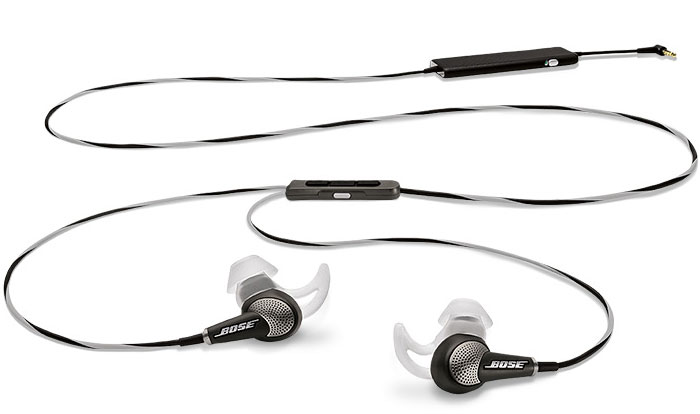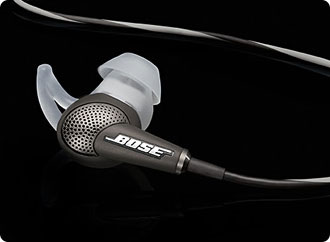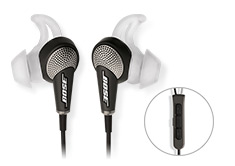
The idea of noise-cancelling headphones is enticing, especially for frequent air travellers. And when it comes to suppressing noise, Bose is without a doubt the bees’ knees. I have tried all the company’s offerings but, while they all work well, none has captured my attention like the latest in-ear QuietComfort 20i model.
Previously I have owned the QC 3, which fits on ear and uses rechargeable batteries and the QC 15 over-ear device which has the advantage of using standard non-rechargeable AAA batteries. Both were uncomfortable for me, although I am probably in a minority with this view. Both, also, are bulky and take up a lot of room in the on-board bag. Many times when travelling light I decided I couldn’t justify packing them.
When I first saw the in-ear QC 20i phones I was sceptical. How could an in-ear design succeed in cutting out all background noise? Could these tiny earphones be worth £260? I tried them in my local Bose store and was definitely impressed, so much so that I immediately put the bulkier QC15s for sale on eBay. Still, I didn’t rush into buying the 20i and decided to do some research.
Another, longer visit to Bose and I was sold on the 20i. As far as I could tell, these earphones are just as effective at noise suppression as their bigger brethren. The sound reproduction is also excellent. I am no audiophile and, frankly, the ultimate in audio technology is wasted on me. The Bose MIE2i phones were perfectly good as far as I am concerned; and the QC20i phones are just as satisfactory, if not more so. If in doubt, visit a Bose store and take a test to see if the sound is for you. To my ear, the phones have plenty of bass and a pleasant overall rendition. I would rate them better than the Etymotic hf3 which, despite the expensive made-to-measure ear-canal silicon earbuds, I never found truly comfortable.
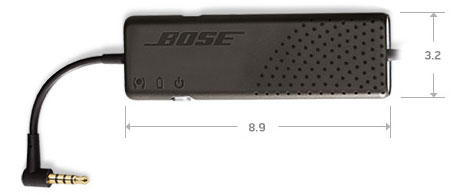
All electronic noise-suppression earphones require a powered unit and, in the case of the QC 20i, this takes the form of a slim oblong wafer (8.9 x 3.2 x 0.95cm) which has a very short (~5cm) cable to attach to the source. It is always right next to your iPhone or iPad and this can sometimes be an inconvenience. However, given the choice, it is perhaps a better location for the gubbins than in mid-cable or nearer to the headset.
The electronic unit is charged with a standard micro USB cable which is supplied by Bose, although you have to provide your own charger. An iPhone charger or, even, the USB port of a computer will do the trick. I am all in favour of USB charging because it means there is one less item to pack (or to forget more likely). The unit features an on-off slider switch and two status LEDs―one for battery charge and one for Aware mode (which allows you to hear some surrounding sound and which is toggled from the in-line remote controller). All in all, it is a slim and attractive appendage and is a small price to pay for the noise-cancelling capabilities of the headphones.
Charging time is two hours and the battery should last 16 hours between top-ups. If you do run out, during a flight for instance, the earphones will lose the noise cancellation but will continue to function.
Chocolate rules
Apart from the rather unattractive two-tone chocolate brown colour, the 20i looks identical to the MIE2i phones which I bought a couple of years ago. As with these traditional earphones, the cable ends in a control module with an on/off button and the familiar back/forward/pause buttons. There is a microphone to provide integration with the iPhone (note that an alternative model, the QC 20 is available for non-Apple hardware).
On the side of the module is a mode button which is not found on the standard MIE2i phones. This toggles full noise suppression and partial suppression so you can choose to hear what is going on around you without removing the pods. This is particularly useful when the flight attendant asks whether you prefer red or white wine. From this control pod branch the two cables for the left and right ear pods. The position of the control unit is fixed so there is no adjustment of cable length possible.
The two ear buds fit snugly in my ears, unlike many competing units, and are held effectively in place by the soft rubber wings (“StayEar” in Bose speak) which slot into the ear cavity. These wings are similar to those seen on other Bose earphones such as the MIE2i and, while they may look a bit nerdy, they are extremely effective in gripping the ear. Three sizes of winged bud are supplied so you can be sure of a good fit in any ear.
The markings on the ear pods to indicate left or right are very indistinct and are almost invisible in poor light. I came to rely on the rubber wings to help me decide which ear is which. The wings should face backwards when installed inside the ear so it is easy to tell left from right.
Soon after purchase I got the chance to try the QC 20is on a ten-hour flight from London to Beijing and my initial in-store impressions of the noise-cancelling abilities were confirmed. A good test is first to listen to music with standard earphones, such as Apple’s basic model or, even, the Bose MIE2i. Then swap to the QC 20i and you are met with total silence until the music or speech comes through loud and clear without any distractions. There is no need to ramp up the volume in order to overcome the background noise because there isn’t any. The noise of the plane is a subdued whisper, barely audible. Even loud voices in the vicinity go unnoticed. Having tried all the Bose noise-cancelling earphones I believe the QC 20i is as good as, if not better than the larger headsets.
Comfort is exceptional. Normally, with any type of earphone―in, on or over ear―I begin to feel discomfort after an hour or so. Not so with the QC 20i. These are definitely the most comfortable earphones of any configuration I have ever used.
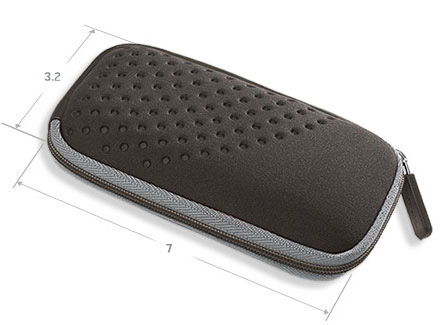
When you read about noise-cancelling earphones you naturally think about improving the experience of listening to music. In reality, these in-ear Bose phones are just as good when listening to nothing. Pure silence can be immensely gratifying. I found the phones useful when trying to sleep on a flight. They cut out all the annoying stuff, including the all-too-frequent announcements about duty free. I even used them in a noisy city-centre hotel during my visit to China and I can confirm that they are more effective than earplugs.
Verdict
The QC 20i earphones offer classic simplicity of design and extreme functionality. The supplied pouch is very compact (3.2 x 7cm) and includes an accessory pocket for spare silicon winged buds and the satisfyingly short USB cable. But are they worth £265? To my mind the answer is an unequivocal yes. I would regard them as an essential travellers’ accessory simply for the noise cancellation, let alone the pleasure of listening to pure music without background distraction. I can also say that they are not just smaller but better than the QC15 (£300) and QC3 (£260) headsets. They are a prime example of less being more.
Product photographs courtesy of Bose
Afterthoughts: Following more real-world use of the Bose QC20i headphones I admit I might have been a tad inaccurate in the use of the world silence. In a very noisy area (I am thinking of the deck of a crowded Easter ferry meandering among the Aegean Islands–and Greeks are nothing if not loud), I have realised that there is a very feint background hubbub which is so subdued that it is completely obliterated when listening to music. The odd thing is that people right next to you are are unheard but the hubbub comes from the distance. On an aircraft, voices are usually local, therefore well suppressed, and the headphones do an excellent job coping with the constant hum of the aircraft. I have no reason to alter my glowing testimony of the 20i phones; they really do suppress noise to a remarkable extent. But, if we wish to split hairs, silence it is not.

